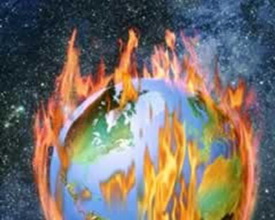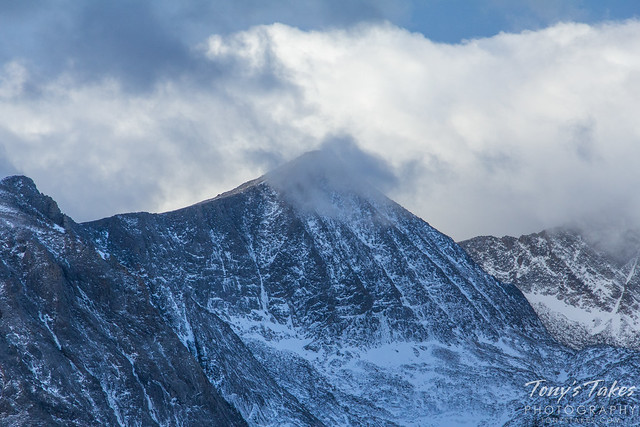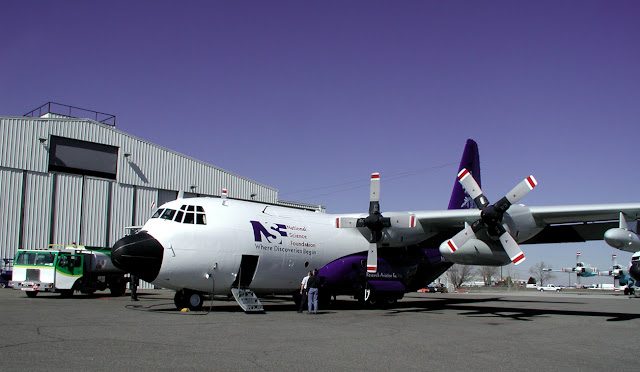|
Carol Rasmussen, NASA Using satellite data on how water moves around Earth, NASA scientists have solved two mysteries about wobbles in the planet’s rotation – one new and one more than a century old. The research may help improve our knowledge of past and future climate. Although a desktop globe always spins smoothly around the axis… Continue reading Two Mysteries About Wobbling Earth Have Been Solved |
Category Archives: Climate Change
Plan B: Hacking the climate
|
Scientists are exploring technological fixes to slow the earth’s warming. Are they trying to save the planet, or play god? Los Angeles (dpa) – In a laboratory in the US Pacific north-west, scientists are working on what could one day become a new, and controversial, weapon to fight global warming: clouds. Misting ocean clouds with saltwater… Continue reading Plan B: Hacking the climate |
California governor’s attempt to link climate change and wildfires disputed by scientists
 It is a familiar refrain from climate change alarmists: This latest wildfire (or hurricane or tornado or rain event) is the worst we have ever seen and manmade climate change is to blame. The fact is though that these over-the-top claims rarely are true.
It is a familiar refrain from climate change alarmists: This latest wildfire (or hurricane or tornado or rain event) is the worst we have ever seen and manmade climate change is to blame. The fact is though that these over-the-top claims rarely are true.
Certainly California has seen some devastating wildfires this season. Governor Jerry Brown was quick to jump on the ‘blame climate change’ bandwagon.
With the Rocky Fire still smoldering in northern California, the governor used his bully pulpit to push his agenda:
“California is burning,” the governor dramatically declared. “What the hell are you going to do about it?
“This is a wake-up call. We have to start coming to our senses. This is not a game of politics. We need to limit our carbon pollution. These are real lives and real people. This problem cannot be solved year by year.”
“The fires are changing…. The way this fire performed, it’s not the way it usually has been. Going in lots of directions, moving fast, even without hot winds.”
Governor Brown’s statements do sound dire and make one believe that the wildfires and their behavior are unprecedented. However, as the LA Times reported yesterday, the link between the blazes and climate change is tenuous at best.
But scientists who study climate change and fire behavior say their work does not show a link between this year’s wildfires and global warming, or support Brown’s assertion that fires are now unpredictable and unprecedented. There is not enough evidence, they say.
University of Colorado climate change specialist Roger Pielke said Brown is engaging in “noble-cause corruption.”
Pielke said it is easier to make a political case for change using immediate and local threats, rather than those on a global scale, especially given the subtleties of climate change research, which features probabilities subject to wide margins of error and contradiction by other findings.
“That is the nature of politics,” Pielke said, “but sometimes the science really has to matter.”
Historical fire suppression policies and land management are considered to be far larger concerns and are more likely to have contributed to the wildfires.
Wildfires are of course not the only natural disaster that gets blamed on climate change. Indeed, many have blamed the Golden State’s drought on global warming but there is little evidence to back the claim. In a study, NOAA said, “natural oceanic and atmospheric patterns are the primary drivers behind California’s ongoing drought.”
Despite the facts that show these events are cyclical and natural, you can be assured political leaders and activist scientists will continue to use them to push their climate change agenda.
EPA Spill Conspiracy Theories Gain Traction in Utah Legislature
|
Within days of the U.S. Environmental Protection Agency’s accidental release of 3 million gallons of mining wastewater into the Animas River in Colorado, portions of the Internet frothed over with conspiracy theories that the EPA spill may not have been an accident. Now, that line of thinking has found its way to the Utah legislature. And… Continue reading EPA Spill Conspiracy Theories Gain Traction in Utah Legislature |
Global warming: Deceptive temperature record claims
|
The U.S. government is at it again, hyping meaningless records in a parameter that does not exist in order to frighten us about something that doesn’t matter. NASA and the National Oceanic and Atmospheric Administration (NOAA) announced this week that according to their calculations, July 2015 was the hottest month since instrumental records began in 1880.… Continue reading Global warming: Deceptive temperature record claims |
A Real Climate Scientist Demolishes Bill Nye’s Global Warming Alarmism
|
By Michael Bastasch Global warming alarmist talking heads like Bill Nye, Neil deGrasse Tyson and Al Gore are constantly paraded around as experts on climate, often claiming that global warming is making weather more extreme and bashing those who “deny” that humans are the main culprit behind this. So, Fox Business host John Stossel brought in… Continue reading A Real Climate Scientist Demolishes Bill Nye’s Global Warming Alarmism |
Obama power plant rules spark 2016 fight over climate change
|
WASHINGTON (AP) – President Barack Obama’s sweeping new power plant regulations are thrusting the divisive debate over climate change into the race for the White House, with candidates in both parties seeing an opportunity to capitalize. To Democrats, rallying around global climate change is a way to energize liberal supporters and paint Republicans as out of… Continue reading Obama power plant rules spark 2016 fight over climate change |
Study: Mountain Monitoring System Artificially Inflates Temperature Increases at Higher Elevations

We have all heard the warnings about a warming climate and scientists have claimed to have the data to prove it. However time and time again the very underlying data has been shown to be faulty. Here we again find another case.
A new study from the University of Montana shows extreme warming bias in temperature data from critical networks. The study takes a hard look at climate data gathered across the Rocky Mountain west, including here in Colorado.
“In the context of a warming climate, this artificial amplification of mountain climate trends has likely compromised our ability to accurately attribute climate change impacts across the mountainous western US,” author Jared Oyler writes in his study.
From the University of Montana:
January 12, 2015
MISSOULA – In a recent study, University of Montana and Montana Climate Office researcher Jared Oyler found that while the western U.S. has warmed, recently observed warming in the mountains of the western U.S. likely is not as large as previously supposed.
His results, published Jan. 9 in the journal Geophysical Research Letters, show that sensor changes have significantly biased temperature observations from the Snowpack Telemetry (SNOTEL) station network.
More than 700 SNOTEL sites monitor temperature and snowpack across the mountainous western U.S. SNOTEL provides critical data for water supply forecasts. Researchers often use SNOTEL data to study mountain climate trends and impacts to mountain hydrology and ecology.
Oyler and his co-authors applied statistical techniques to account for biases introduced when equipment was switched at SNOTEL sites in the mid-1990s to mid-2000s. His revised datasets reduced the biases to reveal that high-elevation minimum temperatures were warming only slightly more than minimum temperatures at lower elevations.
“Observations from other station networks clearly show that the western U.S. has experienced regional warming,” Oyler said, “but to assess current and future climate change impacts to snowpack and important mountain ecosystem processes, we need accurate observations from the high elevation areas only covered by the SNOTEL network. The SNOTEL bias has likely compromised our ability to understand the unique drivers and impacts of climate change in western U.S. mountains.”
Co-authors on the paper “Artificial Amplification of Warming Trends Across the Mountains of the Western United States” include UM researchers Solomon Dobrowski, Ashley Ballantyne, Anna Klene and Steve Running. It is available online at http://onlinelibrary.wiley.com/enhanced/doi/10.1002/2014GL062803/.
###
Contact: Jared Oyler, Montana Climate Office, 215-260-4487, jared.oyler@ntsg.umt.edu.
On the net: Study: US Weather Stations Exaggerated Warming In Western Mountains
NCAR launches study of Colorado Front Range ozone pollution

Over the past week you may have noticed a relatively persistent ‘drone’ of aircraft over the Denver area and seen a relatively large aircraft flying overhead. The plane is a specially outfitted C-130 taking part in a major field study of the Front Range’s ozone.
Scientists at the National Center for Atmospheric Research (NCAR) will be using the aircraft, radar, balloons and other sensors and systems in the coming weeks. The project has many goals including mapping possible sources of ozone pollution and using the data to better interpret satellite data.
SCIENTISTS LAUNCH FAR-RANGING CAMPAIGN TO DETAIL FRONT RANGE AIR POLLUTION
BOULDER – Scientists at the National Center for Atmospheric Research (NCAR) and partner organizations are launching a major field project across the northern Front Range of Colorado this month to track the origins of summertime ozone, an invisible but harmful pollutant.
The researchers will use specially equipped aircraft, mobile radars, balloon-mounted sensors, and sophisticated computer simulations to measure local and far-flung pollution sources. Results from the month-long study will provide needed information to officials seeking to ensure that air in the region is healthy to breathe.
It marks one of the largest research projects to look at summertime air pollution on the northern Front Range, including Denver, which often exceeds federal standards for safe levels of ground-level ozone pollution despite efforts to reduce emissions. Ozone can lead to increased asthma attacks and other respiratory ailments. It also damages vegetation, including crops.
“Our goal is to produce an accurate and detailed view of all the diverse sources of ozone pollution along the Front Range,” said NCAR scientist Gabriele Pfister, a principal investigator on the project. “We want to fingerprint where the pollution comes from and analyze what happens when it mixes in the atmosphere.”
Known as the Front Range Air Pollution and Photochemistry Experiment (FRAPPÉ), the study will track emissions from both human-related activities and natural sources. It will focus on the urban corridor from south of Denver, north to Fort Collins, as well as the adjacent plains and mountains. Scientists also want to determine how much pollution comes from upwind areas, including other states and countries.
Funded through a federal-state partnership, FRAPPÉ is supported by the Colorado Department of Public Health and Environment and by the National Science Foundation, which is NCAR’s sponsor.
TWO MAJOR PROJECTS CONVERGE
To provide additional detail across the region, scientists will closely coordinate FRAPPÉ with a second air quality mission taking place on the Front Range at the same time. DISCOVER-AQ (Deriving Information on Surface Conditions from Column and Vertically Resolved Observations Relevant to Air Quality) is a major study led by NASA that seeks to improve the ability of satellites to usefully assess our air quality.
“What we learn from these flights will help us to better interpret satellite remote sensing of air quality from geostationary orbit in the future,” said NASA scientist Jim Crawford, a principal investigator on DISCOVER-AQ. “It also will help us to define the best combination of instruments on the ground to connect air quality monitoring networks with satellite information.”
The DISCOVER-AQ flights and ground observations will focus on the northern Front Range, while FRAPPÉ will gather measurements from the surrounding region.
In all, approximately 200 scientists, technicians, pilots, and students from around the country will converge on the Front Range for the combined projects.
The researchers will quantify emissions from industrial facilities, power plants, motor vehicles, agricultural operations, oil and gas drilling, fires, and other sources. They also will measure naturally occurring emissions from trees and other plants that then combine with emissions generated by human activity to form ozone and other pollutants.
PROFILING AIR QUALITY IN THREE DIMENSIONS
Colorado, like other states, relies on a limited number of ground-based stations to monitor air quality and help guide statewide policies and permitting. But a full, three-dimensional picture of the processes that affect air quality, including conditions far upwind and high up in the atmosphere, requires a three-pronged approach with measurements from aircraft, satellites, and the ground.
“By bringing together aircraft, satellites, and ground-based instruments, we can analyze the amounts and types of pollutants that are emitted in the Front Range as well as transported from other places, how they evolve, and how air circulation patterns near the mountains move them around,” said NCAR scientist Frank Flocke, a principal investigator on FRAPPÉ.
During the projects, which run from July 16 to mid-August, Front Range residents may notice occasional low-flying research aircraft that are taking measurements of the atmosphere. The aircraft will spiral down at times, taking samples of air as they spiral directly above ground instruments that will be measuring air at the surface and observing the atmosphere above.
Ozone, a principal component of smog, forms from the reaction of hydrocarbons and carbon monoxide in the presence of nitrogen oxides (NOx) and sunlight. It peaks during summer months when sunlight is strongest and air conditions are more likely to be stagnant.
Although the scientists will focus on ozone, they will also measure the size and chemical composition of airborne particles to better quantify particle pollution and track its sources. Microscopic airborne particles can have a major impact on people’s respiratory health.
The data gathered by the projects will go through a quality assurance process and then become publicly available in about six months. Scientists will use the data to begin publishing research results in about a year.
AN ARMADA OF INSTRUMENTS
FRAPPÉ and DISCOVER-AQ will use similar payloads for their aircraft. The teams will conduct wingtip-to-wingtip intercomparison flights several times during the project, sampling air in the same place to make sure the instrument readings are comparable.
A network of instruments on towers, rooftops, and other sites will continuously monitor ozone and the gases that react to form it. Other ground-based activities, such as measurements from tethered balloons and from lidars (laser-based radars), will be closely coordinated with the flights. The researchers will draw on forecasts and nowcasts of both weather and air quality from a large number of computer models to assess daily conditions and make final decisions on when to fly and where to gather atmospheric samples.
“This is a unique opportunity for the state to work with others on a study that combines ground-based measurements with aircraft-borne sensing,” said Will Allison, director of the Colorado Department of Public Health and Environment’s Air Pollution Control Division. “It will help us more fully understand complex questions such as the factors contributing to ozone formation in the region. And that will help us continue to implement effective measures to reduce air pollution.”
“FRAPPÉ is a major collaborative study that will produce the most complete picture ever of summertime air pollution on the Front Range,” said Thomas Bogdan, president of the University Corporation for Atmospheric Research, which manages NCAR. “This effort will dramatically advance our understanding of air quality and its potential impacts. The results have the potential to help not only people living on Colorado’s Front Range, but residents of other metropolitan areas with similar conditions, too.”
In addition to NCAR and the Colorado Department of Public Health and Environment, the FRAPPÉ team includes scientists from the National Oceanic and Atmospheric Administration; Cooperative Institute for Research in Environmental Sciences; National Park Service; Regional Air Quality Council; Global Ozone Project; Western Regional Air Partnership; Environmental Protection Agency; University of Colorado Boulder; Colorado State University; University of California, Berkeley; University of Wisconsin; University of Cincinnati; Georgia Institute of Technology; University of California, Riverside; Aerodyne Inc.; U.S. Naval Academy; University of Rhode Island; University of California, Irvine; and Princeton University.
Greenpeace co-founder says ‘no scientific proof’ humans cause climate change
|
|
